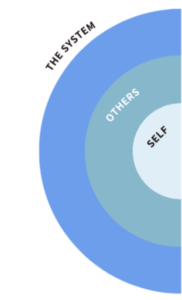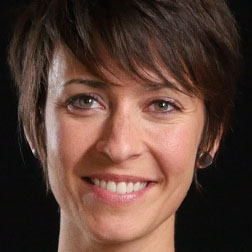Your facilitative leadership is perfectly positioned to make a difference, to help make your groups flourish, but knowing what to do when the culture itself is under performing is another matter altogether.
- “I get this feeling that my group could be better, but I am at a loss about how to reach higher levels of impact or performance.“
- “Some group members are grumbling about our meetings, but I am not sure how to fix it – they say it’s not my leadership, but it’s not clear what could be improved.”
- “We used to feel really connected last year, but now that we have two new members, our group can’t seem to get in the groove again.”
These real examples point out how ‘culture’ can be somewhat mysterious and challenging. Culture is an intangible and subtle topic, which means that it is hard to see some of the contributing dynamics clearly, as they come from ‘‘under the waterline’ of what is observable on the surface.
When I coach and counsel leaders to start to tune in to how participation is happening with fresh eyes — so that they can be more precise about what they’d like to improve or change — one of the first areas to place our attention is to notice what we experience in the here and now.
We start these conversations by focusing on two key questions:
- How do people contribute to your group meetings now?
- What are you looking for vis a vis participation in your groups? How would you like to evolve it?
This post unpacks how we can address the questions and also learn new ways of seeing and acting on the group culture as a system by using the lens of participation.
So, I’ll invite you to reflect on this question: How do people contribute to YOUR group meetings now?
- What do you notice about the quality of their engagement and energy? For example, is the group withholding trust? Are conversations superficial? Is the emotional intensity higher than it used to be, and more unpredictable?
Even the simple distinction between the individual and the collective can powerfully sharpen your view of participation. For example, are these qualities being expressed by the whole group (the collective view), or is there a difference from person to person (the individual view)?
As facilitative leaders, or group leaders, we sometimes over-index on ONE person’s actions. For example, we can get captured by a binary assessment of “is this person going along or are they not going along”? Unconscious judgment and projections can arise about whether people are ‘good or bad’, ‘team players or mavericks’. From this perspective, the provocative and unusual attracts more attention, and we may have blind spots or be less aware of the group as a whole – as a social system – so opportunities to elevate the group and its purpose in being together may stay hidden, under the waterline.
In contrast to solely focusing on individuals, when you use the lens of participation, you start to see more than the individual group member, and you can take in the group – as a system. This system’s view encompasses your self, the individual members, and the entire group as a whole. Participation looks ‘at the group as a system’ by noticing how the parts and the whole are participating and are interrelated.

This lens provides a wider field in which you can notice and influence the relational domain and take account of the interdependencies that are at play. No person in your group is an island.
Practically speaking, the lens of participation helps you to include interpersonal, individual, and intrapersonal indicators that indicate how the group / the individuals are doing, and to see opportunities to refine the group system in service of the group’s purpose.
Taking this system’s view is one part of a more masterful approach.
And, being able to see the wide range of behaviors that define the participation you are facilitating is the second part of a more masterful approach.
Focusing on behaviors, which are tangible and objective, helps you to better calibrate to what is actually going on in your group system and to refine your interventions. While underlying intersubjective values and shared intentions are important, they are not the place where you can directly affect change.
Question: “Is more participation a good thing?”
Answer: It depends. What types of participation do you need?
What are you looking for vis a vis participation in YOUR groups? How would you like to evolve it?
I like to think of participation as an evolutionary process – where the quality of participation can be cultivated and developed, and it can improve and grow more impactful over time, under the right conditions.
And, as we pointed out above, knowing where you should start, now, can be confusing.
When you start to notice and observe the diverse range of contributions, and reflect on the varied strengths and perspectives of your members, you can use that information to enhance the overall effectiveness of your meetings through your facilitation. It is not about more participation, per se, but about facilitating the right kinds of participation in a dynamic relationship with the particular intentions and composition of your unique group.
The whole system (with you included) can get an upgrade when you learn to see more and you can draw from a richer collection of data points as you sense and respond with more mastery.
So, how might we use the lens of participation to see what we can shift?
With the right framing, it gets easier to see those crucially important determinants of thriving groups. Here are a few examples: (note: “members” are members of the system, which includes you.)
- Asking Questions: Members ask clarifying questions to gain a better understanding of the topic at hand or to seek further information.
- Acknowledging Shared Humanity: Members have soul, and connect beyond surface features from their shared humanity and humility as imperfect works in progress.
- Offering Insights: They share their expertise and offer valuable insights related to the meeting’s agenda or specific challenges.
- Compromise: Members put down personal interests in order to help the group move ahead.
You are invited to learn more, and participate in our ongoing research and development by completing a Ten Directions’ Participation Audit™. This audit is drawn from our extensive experience working with thousands of leaders, distilled into a comprehensive list of 27 factors that will help you observe qualities and types of participation.
Completing the ‘participation audit’ will broaden your view and ‘see more’ of the ways that people are participating in your groups. You will generate some tangible outputs, including:
- A temperature check on how your group is doing and being, now.
- Clarity about the kind of participation and culture you would like to cultivate.
- A defined relationship between these individual and collective behaviors and your current group agreements.
- Insights into how you relate to your group’s flourishing, and feedback on where to place your attention.
- Some support in creating a practical next step.
Here is the link to start your free Participation Audit™.
If you are not interested in learning about the 27 facets of participation and completing the audit at this time, I’ll leave you with one big question for your group system: How might we facilitate the kind of participation we are yearning for?
In conclusion
This is a work in progress – and I would love to hear how this approach lands for you, what you learned from the exercise, and any questions or suggestions you have. Please share your thoughts in the comments below. With appreciation.



